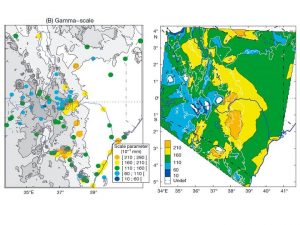l’article du mois – avril 2014
 Spatial interpolation of daily rainfall stochastic generation parameters over East Africa
Spatial interpolation of daily rainfall stochastic generation parameters over East Africa
Par Pierre Camberlin, Wilson Gitau, Pascal Oettli, Laban Ogallo, Benjamin Bois
Paru dans Climate Research (2014), 59, 39:60.
Downscaling seasonal rainfall predictions to daily time-scale, for crop yield simulation
for instance, can be performed using stochastic generators (SGs). The spatial interpolation of
the SG parameters is required to generate rainfall time-series at ungauged places. A methodology
is defined which makes use of topography to interpolate these parameters, in a region with a
rugged terrain covering Kenya and north-eastern Tanzania. A first-order Markov chain was used
to model rainfall occurrence, and a gamma distribution was used to model amounts. The 2 para –
meters of the Markov models, p01 and p11, and the 2 parameters of the gamma distribution are
computed at 121 stations. The Kolmogorov −Smirnov test for goodness-of-fit shows that 88%
(99%) of the stations and months have their dry (wet) spell frequencies successfully reproduced
by first-order Markov chains, and two-third of the stations have their daily amounts satisfactorily
fitted by the gamma distribution. Local regression, using elevation as the predictor and weighting
stations according to distance from the target pixel and to environmental variables, is used to
interpolate the 4 SG para meters. Cross-validation indicates that distance-weighted regression
provides good estimates, but the inclusion of topographical variables (aspect in particular)
improves the results further. The final maps show a strong orographic control of both the Markov
and gamma parameters. However, while elevation has an effect on rainfall occurrence, rainfall
intensity is more strongly related to local slope aspect, with eastward to southeastward oriented
foothills and coastlines displaying the highest gamma scale values. These results suggest that a
statistical disaggregation of daily rainfall is improved by taking explicitly into account topography
through its effect on the spatial distribution of SG parameters.
- extrait:
- lien_externe:
- kc_data:
- a:8:{i:0;s:0:"";s:4:"mode";s:0:"";s:3:"css";s:0:"";s:9:"max_width";s:0:"";s:7:"classes";s:0:"";s:9:"thumbnail";s:0:"";s:9:"collapsed";s:0:"";s:9:"optimized";s:0:"";}
- kc_raw_content:
 Spatial interpolation of daily rainfall stochastic generation parameters over East Africa
Spatial interpolation of daily rainfall stochastic generation parameters over East AfricaPar Pierre Camberlin, Wilson Gitau, Pascal Oettli, Laban Ogallo, Benjamin Bois
Paru dans Climate Research (2014), 59, 39:60.
Downscaling seasonal rainfall predictions to daily time-scale, for crop yield simulationfor instance, can be performed using stochastic generators (SGs). The spatial interpolation ofthe SG parameters is required to generate rainfall time-series at ungauged places. A methodologyis defined which makes use of topography to interpolate these parameters, in a region with arugged terrain covering Kenya and north-eastern Tanzania. A first-order Markov chain was usedto model rainfall occurrence, and a gamma distribution was used to model amounts. The 2 para -meters of the Markov models, p01 and p11, and the 2 parameters of the gamma distribution arecomputed at 121 stations. The Kolmogorov −Smirnov test for goodness-of-fit shows that 88%(99%) of the stations and months have their dry (wet) spell frequencies successfully reproducedby first-order Markov chains, and two-third of the stations have their daily amounts satisfactorilyfitted by the gamma distribution. Local regression, using elevation as the predictor and weightingstations according to distance from the target pixel and to environmental variables, is used tointerpolate the 4 SG para meters. Cross-validation indicates that distance-weighted regressionprovides good estimates, but the inclusion of topographical variables (aspect in particular)improves the results further. The final maps show a strong orographic control of both the Markovand gamma parameters. However, while elevation has an effect on rainfall occurrence, rainfallintensity is more strongly related to local slope aspect, with eastward to southeastward orientedfoothills and coastlines displaying the highest gamma scale values. These results suggest that astatistical disaggregation of daily rainfall is improved by taking explicitly into account topographythrough its effect on the spatial distribution of SG parameters.
